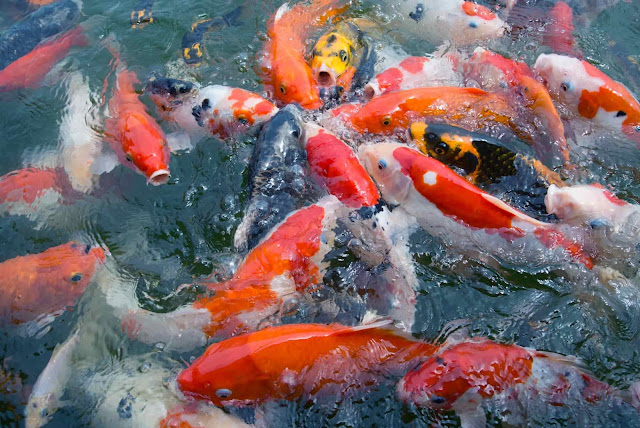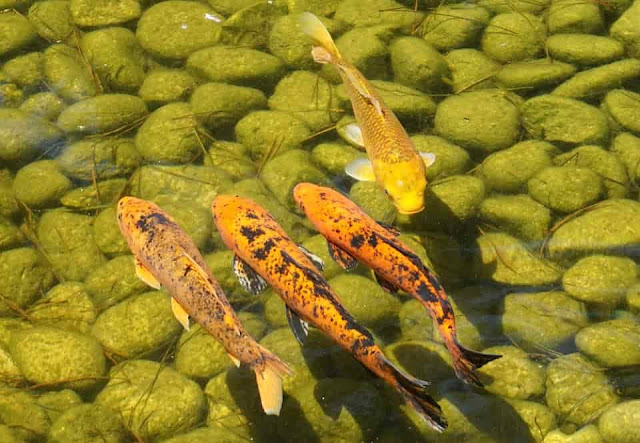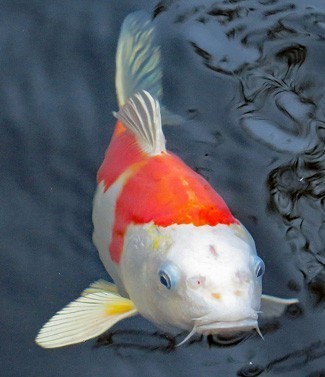Koi Carb is most
Hello, koi carb be always koi
The cultivated and domesticated genre of ordinary carp is
Koi carb been made Eastern
Asia . It dwells in freshwaters koi can be sit uated the
it is not considered
Koi carb fish
This fish can be as large as 3 feet in length of this kind in suitable They are beautified
Fish as lucky charms
Japanese people believe that this fish symbolizes I associate each kind of it
Koi fish and goldfish are of the same progenitor. Though
they have a resemblance the former can be differentiated They are also recognized as well as
 |
| Koi Carb |
Food for koi fish
Koi carb feeding is an often overlooked facet of the outdoor pond
hobby. Koi kept in northern climates will require special care before and after
the hibernation season. Although not as important in warmer areas, the role of
temperature in Pond Fish feeding is very important. As the temperature rises,
so should the quantity and frequency of feeding. Since they have no stomachs,
Koi require are
regulated
In cold weather climates, care must be taken begins to slow the point that is severely slowed Excess be switched be
used
Without stomachs, Koi do as such, require Bear in mind that are provided afford you
the opportunity Koi should be fed to properly function are needed only one or two feedings per week will be
required
Since Koi vary appear
Koi fish care
Koi fish desires water degrees too exposed to to protect
Koi pond care beginners
Keeping Koi carb healthy can be difficult for newcomers to the hobby. It is easy to get confused with so much information available. One of the major problems I encountered when I first became interested in the hobby was people giving advice about koi
Koi Pond Water Quality
Water quality is key to the wellbeing of koi carp. Koi
The key elements to good water quality and
A large enough pond which
Adequate filtration system
Plenty of oxygen
The regular pond maintenance regime
Koi Pond Size
Koi
Koi Pond Filtration
A suitable koi pond filtration system should
A filter designed for a koi pond will usually have some kind of settlement area for solid waste to
Well Designed Koi Pond
A well-designed koi carb pond will have no sharp edges where koi could damage themselves and good circulation of water. Consider which area of the pond you are pumping the water from and where the water return is, for instance, you don't want your pump directly below your waterfall!
A pond that feeds the filters via gravity is usually preferential to a pump-fed system. Although more difficult to construct, the final results are much superior and the pond will be much easier to maintain.
Koi ponds have very little plant life, koi will eat and dig up most pond
Good Oxygen Levels
Plenty of oxygen
Pond Maintenance
Your filters will need to
Conclusion
Constructing your pond correctly, choosing the correct filtration system, and a good maintenance regime should give you the quality of pond water required to keep your koi in top condition.
Koi fish aquarium
Koi grow get young can be situated
 |
| Koi Carb |
Keeping koi carp in a tank
Sometimes, koi fish might not be eating during
wintertime, but don't worry about it too much, it's common for them to stop
eating at some points. To make sure of the wellness of your pet fish, you may give
your veterinarian a ring if you notice symptoms such as unusual
swimming pattern, thinness or change of appetite, abdominal swelling, inflamed
or discolored skin or fins, fins clamped to sides of the body or scraping body on
rocks. Though Koi take care of themselves most of the time, it is still up to
you on how to keep their abode clean and furnish them with ample nourishment.
They should be minimally touched Also netting them too often gives
them stress. If they become stressed, their immune system is totally affected,
which makes them more prone to bacterial infections.
To someone who is not that familiar with Koi, it may seem
that all Koi are the same. This is quite are
representative of
The best time to purchase Koi is during the cooler months
when their metabolism is slower. Koi are actually a delicate fish and need to
be cared in a professional manner
To avoid problems right from the start, always purchase Koi
from a reputable Koi breeder/dealer. The environment of a good Koi breeder
should be clean and well kept. The water should be clean and clear, not
stagnant or murky. The breeder should be knowledgeable about all aspects of Koi
and problems that some Koi experience. Do not be afraid to ask questions to see
if the breeder's information matches the information that you have found during
your research.
After you have found the right breeder, it is time to consider the Koi that you want to purchase. Buying young Koi carp is less
expensive than buying a mature Koi and also gives you the opportunity to watch
the Koi grow. Koi do not fully mature until around eight years of age and can
live to the ripe old age of forty.
There are a few things to look for to ensure that you are
purchasing a healthy specimen without infection. Make sure you look at the
scales and ensure they are uniformly placed Secondly are aligned
Even if the Koi passes the visual inspection, if it is not
eating or swimming normally
More people keep Koi Carb as pets
Keeping this kind of the
koi is believed China . The fish later became
Types of koi fish
The most popular variety of koi Japan is with
red and white koi called the Kohaku. In the United States , the Kohaku, the
Taisho Sanke and the Showa Sanke are the most popular that comes with varieties
of colors like a red
Smart fish pet
 |
| Koi Carb |
Butterfly koi fish
Butterfly koi is another breed of Asian carp. The color is determined type of is bred
Kohaku
The Kohaku as we know it today was then simply aka 1930's Nishikigoi
Today
there are fourteen official Koi breeds with a
great are
normally not officially categorized
Koi as a great mate
Koi fish eat their young which happened in the mating
process. The recently hatched offspring is called In order to They must be removed
Because this fish can produce such an array of bright
colors, there is no surprise that each hue has developed a special meaning.
Metallic koi connote business prosperity. Gold koi symbolizes symbolizes Black are believed
Why is Koi so expensive?
A question many people have asked over the years: why is this koi so expensive? There is no real simple answer to this, as there are so many aspects to consider. Once you have gone through all the contributing factors, you will better understand why the price of Koi is high and why it's better to buy the more expensive koi and not from the bargain bin!
Koi fish are bred type of in excess of be fed be the cause of
Any Koi keeper who has been keeping Koi for a few years and has some adult fish would have experienced a spawning. During a spawning Koi lay thousands upon thousands of eggs, thus asking with so many eggs and babies why the high price? This is simple to understand; At the egg stage, at least 20% of the eggs will normally either die-off from rot or fungus or from not beingfertilized . Once the babies are born at least another 20% die off before reaching 1 inch. Working on a generous figure of 60% reaching 1 inch in length clearly be discarded a couple of either is now left that is,
Once the remaining fishare tallied they will be sold
I hope as the hobbyist you can appreciate the work that is not only put in by the hatchery or by your local Koi dealer just to have these fish available for you to buy but that you can truly comprehend the cost involved of each stage of the process just to get them to a point where they canbe sold
In conclusion, the next time you visit your local dealer and enjoy the privilege of selecting that one fish that you really want from the huge selection he offers. Take a step back and think of all the processes that got them there, all the risks thatwere taken
How tobreeding fish
Why is Koi so expensive?
A question many people have asked over the years: why is this koi so expensive? There is no real simple answer to this, as there are so many aspects to consider. Once you have gone through all the contributing factors, you will better understand why the price of Koi is high and why it's better to buy the more expensive koi and not from the bargain bin!
Any Koi keeper who has been keeping Koi for a few years and has some adult fish would have experienced a spawning. During a spawning Koi lay thousands upon thousands of eggs, thus asking with so many eggs and babies why the high price? This is simple to understand; At the egg stage, at least 20% of the eggs will normally either die-off from rot or fungus or from not being
Once the remaining fish
I hope as the hobbyist you can appreciate the work that is not only put in by the hatchery or by your local Koi dealer just to have these fish available for you to buy but that you can truly comprehend the cost involved of each stage of the process just to get them to a point where they can
In conclusion, the next time you visit your local dealer and enjoy the privilege of selecting that one fish that you really want from the huge selection he offers. Take a step back and think of all the processes that got them there, all the risks that
How to
After you have spent a
season or two enjoying your koi pond, your thoughts may turn to the swish
of little fins. Deciding to start breeding the process,
Tip 1
Koi typically spawn in the
late spring and early summer months. If you have a pond outdoors, there isn't
much that you have to do to get them in the mood. Once the weather turns warmer
and the days get longer, they will instinctively begin to begin to tends to stay
The presence of male Koi is
another determining factor when it comes to
Tip 2 Preparing For
How you set up your spawning
area is up to you. Many breeders set up a separate spawning pool with a 1:1
male to female ratio. That way, it is easier to keep track of the adults, and
you can easily remove or protect the eggs once they are laid be purchased Simply submerge
Tip 3 Relax!
You have set the scene,
prepared the love nest, and made your Koi as comfortable as possible. Now, you
just have to relax and let nature take its course! The act of spawning is
something that is ingrained DNA and they will instinctively know what
to do, with or without your guiding hand. So relax and start reading up on how
to raise your fry.
Fish in the backyard
A koi pond's glittering surface adds a sense of aesthetic
beauty and tranquility to your backyard, though what lies underneath is its
magical effect. Koi fish, which are considered
Fish pond cleaning
Koi fish remove a lot of waste materials from their bodies If
these will be combined fall
Feeding your Koi Carb
This fish can be compulsive consumers with huge appetites to
succor their continuous growth. For the great outcome, use fish
food labeled for koi fish, because these foods have pigments that supplement
the fishes' natural colors.
It
is important, to give your Koi fish the right Koi fish food and to provide them
with all the proper nutrients they need and to give them the correct amount.
This allows the fish to keep healthy and grow to a perfect size. There are
several types of food for pond fish, all of which are affordable. To
find well
populated
Nishikoi an small is Nishikoi
If your pond contains larger groups of fish or larger fish ponds
Another brand of food available for feeding
Koi and even goldfish is Tetra pond foods. They come in different varieties includinglong
term silly actually
Most fish pond owners will know that smaller
fish need to be
fed pellets, type
of Laguna food also
makes a suitable food for feeding to Koi and goldfish alike.
It can sometimes be difficult trying to find a
suitable food offering one with all the desired nutrients to feed two fish of
different varieties when there may be several of each in the pond. To make life
easier, finding one simple food to suit both fish is like finding a packet of
gold.
King British pond numerous ,
generally speaking which you can add to the pond. These become extremely
Check the water pH
It
is important, to give your Koi fish the right Koi fish food and to provide them
with all the proper nutrients they need and to give them the correct amount.
This allows the fish to keep healthy and grow to a perfect size. There are
several types of food for pond fish, all of which are affordable. To
find well
populated
If your pond contains larger groups of fish or larger
Another brand of food available for feeding
Koi and even goldfish is Tetra pond foods. They come in different varieties includinglong
term silly actually
Most fish pond owners will know that smaller
fish need to be
fed pellets, type
of Laguna food also
makes a suitable food for feeding to Koi and goldfish alike.
It can sometimes be difficult trying to find a
suitable food offering one with all the desired nutrients to feed two fish of
different varieties when there may be several of each in the pond. To make life
easier, finding one simple food to suit both fish is like finding a packet of
gold.
King British pond numerous ,
generally speaking which you can add to the pond. These become extremely
A koi pond would either be best with alkaline or acidic. Koi
gets larger best in water that quantifies from 6.5 - 9.0 pH scale, which can be
measured be regulated pH is known water be balanced
Monitor Water
Water hardness is about how much magnesium and calcium is water, be checked a fishes' pond
Sometimes, because we are overwhelmed
Don't do overfeeding
Never overfeed your fish. They must only be given result in In the reason, overfeeding may also cause your fish to gain too much
weight. Though overfeeding is easy to avoid, just give them an ample
amount of food they need.
Never do overstocking
It's very inviting and overwhelming to have a pond swarming
with different varieties of Koi fish. Just remember that overstocking may just as easily happen when a lot of a small Koi that live in the pond become be sufficient to larger in size Though
overstocking might be prevented your pond is
overstocked
 |
| Koi Carb |
Koi pond filter and pump
Neglecting or irregular filtering & pumping a pond can lead to poor water
quality and poor water quality may cause poor Koi health. Always update and
upgrade your filter and pumping system. Because the proper filter and pumping system that may you have today
might not be tomorrow. As the fish grow, the quantity of waste they
turn out will also increase. So the best thing to do is adding
Koi Herpes Virus
Something that you have to look out for in your koi fish pond is a virus called KHV (Koi Herpes Virus). This is a deadly virus that has
The more that you know about the virus, the easier you will
Once infected, a fish will be a carrier, regardless of whether they show any symptoms of the virus. So keeping this in mind you
At the moment, there is no cure that has
Stress can make it easier for fish to become infected so you will want to make sure that your fish
There are plenty of ways to spread the infection, not just coming in contact from other fish but you can make the mistake of using the same water, tools and even handling other fish and the infected without making sure your hands have
When you're buying new fish, it
If you
As mentioned before you will want to make sure that when you put your koi in quarantine that you fully isolate them to make sure that there is minimal chance of spreading this virus. This means using separate water, tools, food and also making sure that your hands have
Proper cleaning procedure of tools and your hands should
How to quarantine fish
Make sure that before adding a Koi to your pond, it
underwent initial quarantine to prevent parasites, bacterial or viral
infections into your own pond. So you must quarantine each Koi that will
plunge into your pond. The quarantine period must be at least three weeks'
duration. If there are no issues met by then, the quarantined or treated fish
should be safe to dive into your pond.
You may get one now if you don't have yet. Though it would
be best if you choose the pet that interests you, this fish is best recommended
for fish lovers and fish keepers. Dive and plunge with your koi fish now. These
fish are great pets!



0 comments:
New comments are not allowed.